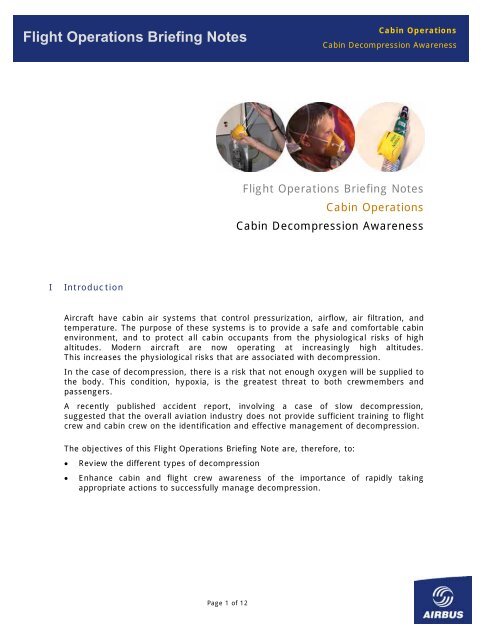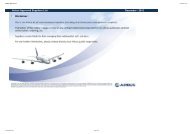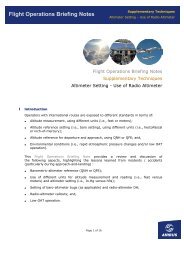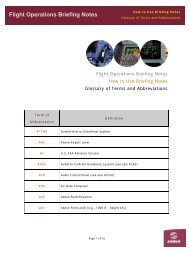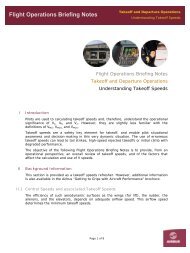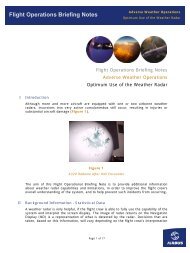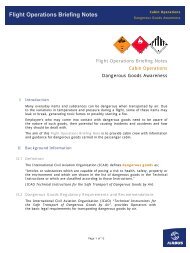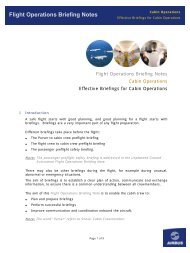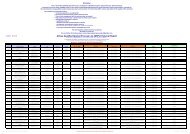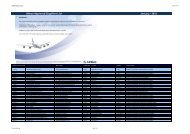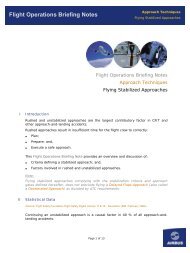Cabin Decompression Awareness - Airbus
Cabin Decompression Awareness - Airbus
Cabin Decompression Awareness - Airbus
Create successful ePaper yourself
Turn your PDF publications into a flip-book with our unique Google optimized e-Paper software.
Flight Operations Briefing Notes<br />
I Introduction<br />
<strong>Cabin</strong> Operations<br />
<strong>Cabin</strong> <strong>Decompression</strong> <strong>Awareness</strong><br />
Flight Operations Briefing Notes<br />
<strong>Cabin</strong> Operations<br />
<strong>Cabin</strong> <strong>Decompression</strong> <strong>Awareness</strong><br />
Aircraft have cabin air systems that control pressurization, airflow, air filtration, and<br />
temperature. The purpose of these systems is to provide a safe and comfortable cabin<br />
environment, and to protect all cabin occupants from the physiological risks of high<br />
altitudes. Modern aircraft are now operating at increasingly high altitudes.<br />
This increases the physiological risks that are associated with decompression.<br />
In the case of decompression, there is a risk that not enough oxygen will be supplied to<br />
the body. This condition, hypoxia, is the greatest threat to both crewmembers and<br />
passengers.<br />
A recently published accident report, involving a case of slow decompression,<br />
suggested that the overall aviation industry does not provide sufficient training to flight<br />
crew and cabin crew on the identification and effective management of decompression.<br />
The objectives of this Flight Operations Briefing Note are, therefore, to:<br />
• Review the different types of decompression<br />
• Enhance cabin and flight crew awareness of the importance of rapidly taking<br />
appropriate actions to successfully manage decompression.<br />
Page 1 of 12
Flight Operations Briefing Notes<br />
II Types of <strong>Decompression</strong><br />
<strong>Cabin</strong> Operations<br />
<strong>Cabin</strong> <strong>Decompression</strong> <strong>Awareness</strong><br />
The risk of a pressurized cabin is the potential for cabin decompression. This can occur<br />
due to a pressurization system malfunction, or damage to the aircraft that causes<br />
a breach in the aircraft structure, enabling cabin air to escape outside the aircraft, for<br />
example loss of a window, or a breach in the aircraft fuselage due to an explosion.<br />
The loss of pressurization can be slow - in case of a small air leak - while a rapid or<br />
explosive decompression occurs suddenly, usually within a few seconds.<br />
The consequences of decompression, and its impact on cabin occupants, depend on<br />
a number of factors, including:<br />
• The size of the cabin: The larger the cabin, the longer the decompression time<br />
• The damage to the aircraft structure: The larger the opening, the faster<br />
the decompression time<br />
• The pressure differential: The greater the pressure differential between the cabin<br />
pressure and the external environmental pressure, the more forceful<br />
the decompression.<br />
When cabin pressure decreases, cabin occupants are no longer protected from<br />
the dangers of high altitudes, and there is an increased risk of hypoxia, decompression,<br />
illness, and hypothermia. It is, therefore, important that crewmembers recognize<br />
the different types of decompression, react effectively to overcome the difficulties<br />
associated with a loss in cabin pressure.<br />
II.1 Rapid/Explosive <strong>Decompression</strong><br />
Rapid/Explosive decompression results in a sudden loss in cabin pressure, and can be<br />
recognized by the following signs:<br />
• A loud bang, thump or clap that is the result of the sudden contact between<br />
the internal and external masses of air<br />
• Cloud of fog or mist in the cabin that is due to the drop in temperature, and<br />
the change of humidity<br />
• Rush of air, as the air exits the cabin<br />
• A decrease in temperature, as the cabin temperature equalizes with the outside air<br />
temperature<br />
• The release of the cabin oxygen masks, when the cabin altitude reaches 14 000<br />
feet.<br />
Page 2 of 12
Flight Operations Briefing Notes<br />
If a breach in the aircraft structure is the cause of the decompression:<br />
• Unsecured items in the immediate area are ejected from the aircraft<br />
• Debris may fly around the cabin<br />
• Loose items may become projectiles<br />
• Dust particles may limit visibility.<br />
<strong>Cabin</strong> Operations<br />
<strong>Cabin</strong> <strong>Decompression</strong> <strong>Awareness</strong><br />
In the case of rapid/explosive decompression, there may be a lot of confusion due to<br />
the high noise level and fog that makes it difficult to communicate in the cabin.<br />
II.2 Slow/Insidious <strong>Decompression</strong><br />
Slow/Insidious decompression involves a very gradual decrease in cabin pressure. Slow<br />
decompression may be the result of a faulty door seal, a malfunction in<br />
the pressurization system, or a cracked window.<br />
Slow decompression may not always be obvious. The cabin crew may not notice<br />
the changes in the cabin, until the oxygen masks drop down from the Passenger<br />
Service Units (PSUs). Therefore, the cabin crew must be aware of signs that could<br />
indicate a slow decompression. In some cases an unusual noise, such as whistling or<br />
hissing sound around the door areas, may be an indication of a slow decompression,<br />
therefore the flight crew should be notified immediately.<br />
One of the first physiological indications of a slow decompression may be ear<br />
discomfort or ‘popping’, joint pain, or stomach pain due to gas expansion.<br />
III Hypoxia<br />
As mentioned, the greatest danger during decompression is hypoxia. To prevent<br />
crewmembers from becoming significantly impaired or incapacitated, the cabin crew<br />
must continuously observe passengers and crewmembers for the signs and symptoms<br />
of hypoxia. The effects of hypoxia (lack of oxygen) cannot be over emphasized.<br />
It is important for the cabin crew to realize that even mild hypoxia, though not fatal,<br />
can have fatal results. This is because hypoxia can significantly reduce<br />
the crewmembers ability to perform, and consequently lead to errors that may be fatal.<br />
The insidious nature of hypoxia causes a subtle decrease in individual performance,<br />
followed by incapacitation, the symptoms may not be identified until it is too late.<br />
The most common type of aviation hypoxia is "hypoxic hypoxia", that occurs due to low<br />
partial pressure of oxygen in the arterial blood. If oxygen is not used immediately in<br />
hypoxia cases, it is possible that occupants become incapacitated and lose<br />
consciousness in a very short time.<br />
Page 3 of 12
Flight Operations Briefing Notes<br />
III.1 Physiological and Psychological Effects of Hypoxia<br />
<strong>Cabin</strong> Operations<br />
<strong>Cabin</strong> <strong>Decompression</strong> <strong>Awareness</strong><br />
It is important that cabin crewmembers be aware of the symptoms of hypoxia in<br />
themselves and in others. During a decompression incident, some of the passengers<br />
may show signs of hypoxia: Some may appear to be dizzy and laughing and some may<br />
not be bothered to put on their oxygen masks.<br />
It is necessary to remember that each person may not react in the same way, and that<br />
the symptoms of hypoxia may manifest themselves differently in each individual.<br />
Initial signs of hypoxia include:<br />
• Stomach pain due to gas expansion<br />
• Tingling sensation in the hands and feet<br />
• Cyanosis (blue discoloration of the lips and fingernails)<br />
• Increased rate of breathing<br />
• Headache<br />
• Nausea<br />
• Light-headedness<br />
• Dizziness<br />
• Sweating<br />
• Irritability<br />
• Euphoria<br />
• Ear discomfort.<br />
These symptoms become more pronounced with the lack of oxygen, for example:<br />
• Impaired vision<br />
• Impaired judgment<br />
• Impaired motor skills (not able to coordinate body movements)<br />
• Drowsiness<br />
• Slurred speech<br />
• Memory loss<br />
• Difficulty to concentrate.<br />
Hypoxia can cause a false sense of well-being. It is possible for a person to be hypoxic<br />
and not be aware of their condition. Therefore, it is important that the cabin crew<br />
recognizes the signs of hypoxia, and provides oxygen as soon as possible, in order to<br />
prevent a loss of consciousness. The affected passenger or crewmember usually<br />
recovers a few minutes after receiving oxygen. However, they may not be aware of<br />
having lost consciousness.<br />
Page 4 of 12
Flight Operations Briefing Notes<br />
III.2 Time of Useful Consciousness<br />
<strong>Cabin</strong> Operations<br />
<strong>Cabin</strong> <strong>Decompression</strong> <strong>Awareness</strong><br />
The time of useful consciousness refers to the time available to individuals to perform<br />
their tasks, after they have been deprived of oxygen, but are still aware of their<br />
environment and capable of controlling their actions.<br />
It is important for the cabin crew to realize that the time of useful consciousness is<br />
different for each individual, and depends on the:<br />
• Altitude<br />
• Individual’s state of health<br />
• Amount of activity.<br />
The cabin crew must remember that, in cases of continued physical activity, the time of<br />
useful consciousness (Table 1) is significantly reduced.<br />
Note:<br />
TIME OF USEFUL CONSCIOUSNESS<br />
Altitude Moderate Activity Sitting Quietly<br />
22 000 feet<br />
25 000 feet<br />
28 000 feet<br />
30 000 feet<br />
35 000 feet<br />
40 000 feet<br />
5 minutes<br />
2 minutes<br />
1 minute<br />
45 seconds<br />
30 seconds<br />
18 seconds<br />
Carlyle, 1963<br />
Table 1<br />
10 minutes<br />
3 minutes<br />
1.5 minutes<br />
1.25 minutes<br />
45 seconds<br />
30 seconds<br />
Time of Useful Consciousness Table at Various Altitudes<br />
It is important to emphasize that this table is only a guideline, and provides average<br />
values that can increase or decrease, depending on the skills needed to accomplish<br />
a task, on the individual’s health, and on the amount of activity. For example, the time<br />
of useful consciousness for a cabin crewmember involved in moderate activity is<br />
significantly less, compared to a passenger that is sitting quietly.<br />
Page 5 of 12
Flight Operations Briefing Notes<br />
<strong>Cabin</strong> Operations<br />
<strong>Cabin</strong> <strong>Decompression</strong> <strong>Awareness</strong><br />
The following are some other factors that can contribute to reducing the time of useful<br />
consciousness:<br />
• Fatigue: A person who is physically or mentally fatigued will have an increased risk<br />
of hypoxia<br />
• Physical effort: During physical activity, there is an increased need for oxygen,<br />
an increased risk of hypoxia and, as a result, a decrease in the amount of useful<br />
consciousness time<br />
• Alcohol: Alcohol can significantly affect behavior, and can increase the risk of<br />
hypoxia, in addition to aggravating some of the behavioral changes resulting from<br />
hypoxia.<br />
IV <strong>Cabin</strong> <strong>Decompression</strong> Procedure<br />
In 1995, a study conducted by the Civil Aero Medical Institute (CAMI) in the United<br />
States, entitled “Flight Attendant Procedures in a <strong>Decompression</strong>”, revealed that<br />
accident investigators, and safety inspectors reported that cabin crew did not follow<br />
the recommended procedures during decompression. This study resulted in a Flight<br />
Standards Information Bulletin (FSIB released by the FAA), that provides<br />
the recommended procedures in a cabin decompression event.<br />
IV.1 Immediate Actions<br />
In the case of decompression the immediate use of oxygen is critical. Therefore,<br />
the first actions to be performed by the cabin crew are:<br />
• Immediately don the nearest oxygen mask<br />
• Sit down fasten your seat belt, or grasp a fixed object<br />
• Hold on.<br />
If the cabin crew is not able to sit down or grasp a fixed object, they should wedge<br />
themselves between passengers and ask passengers for assistance. For example, in<br />
one cabin decompression event, a cabin crewmember was saved from ejection out of<br />
the aircraft, because a passenger was holding on to the cabin crewmember's ankle.<br />
The priority of the cabin crew is to consider their personal safety.<br />
Incapacitated or injured cabin crewmembers will not be able to assist other cabin<br />
crewmembers and passenger during the post-decompression phase.<br />
V <strong>Cabin</strong> - Cockpit Communication<br />
During any emergency, effective crew communication is critical to a successful<br />
outcome. Effective Crew Resource Management (CRM) involves cooperation and<br />
Page 6 of 12
Flight Operations Briefing Notes<br />
<strong>Cabin</strong> Operations<br />
<strong>Cabin</strong> <strong>Decompression</strong> <strong>Awareness</strong><br />
communication between the flight and cabin crew. In many abnormal and emergency<br />
situations, the cabin crew plays an important role in helping the flight crew to identify<br />
and resolve developing problems.<br />
Many incident and accident reports have revealed that effective crew communication,<br />
between flight and cabin crew, can make the difference between an accident and<br />
an incident. It has also been revealed that ineffective communication between the flight<br />
and cabin crew has contributed to the severity of an accident.<br />
V.1 When in Doubt<br />
<strong>Cabin</strong> crew are trained to anticipate the occurrence of specific actions during specific<br />
events. In the case of decompression, for example, it would be quite reasonable for<br />
the cabin crew to expect the flight crew to make an emergency descent. However,<br />
when the expected does not happen, how should the cabin crew react if the oxygen<br />
masks deploy and the aircraft continues to climb?<br />
This type of scenario was stated in a recently published accident report involving a slow<br />
decompression. In this accident, the aircraft continued to climb.<br />
Today, this type of scenario is rare. However it is important to consider how the cabin<br />
crew should react in this type of event.<br />
In this case, the cabin crewmember seated closest to the cockpit, should immediately<br />
notify the flight crew of the oxygen mask deployment, and also to confirm that<br />
the flight crew have donned their oxygen masks.<br />
This highlights the importance of crew communication. It is vital to the safety of<br />
the flight that open communication is maintained between the cabin crew and the flight<br />
crew.<br />
When the expected does not happen, the cabin crew must take the initiative to<br />
seek and find an explanation.<br />
If the cabin crew suspects that the safety of the flight is at risk, or that there is<br />
any indication of an abnormal situation, the cabin crew must immediately notify<br />
the flight crew.<br />
V.2 Crew Communication in a Noisy Environment<br />
In the case of rapid/explosive decompression, the level of noise will be very high.<br />
Therefore, this makes communication difficult between the flight crew and the cabin<br />
crew, and equally between the cabin crew and the passengers. Due to the fact that<br />
effective communication is vital during any emergency, the cabin crew should use any<br />
available form of communication. For example, in several accidents involving<br />
rapid/explosive decompression, cabin and flight crews were forced to communicate via<br />
hand signals and gestures. <strong>Cabin</strong> crewmembers must, therefore, be prepared to<br />
improvise and use their imagination!<br />
Page 7 of 12
Flight Operations Briefing Notes<br />
VI Post <strong>Decompression</strong><br />
<strong>Cabin</strong> Operations<br />
<strong>Cabin</strong> <strong>Decompression</strong> <strong>Awareness</strong><br />
After a decompression, when the aircraft reaches a safe altitude, the cabin crew can<br />
move around the cabin, and should use the portable oxygen cylinders until they are<br />
confident that they can breathe without support.<br />
When the emergency descent is completed, and a safe altitude is reached, the cabin<br />
crew should consider their oxygen requirements. Due to the physical activity at<br />
an increased altitude, the cabin crew may still be exposed to hypoxia. Oxygen<br />
deprivation can be insidious and the cabin crew may not be the best judges of their<br />
own oxygen intake after decompression.<br />
After cabin decompression, the cabin crew should:<br />
• Check on the flight crew, and be prepared to assist in the case of pilot<br />
incapacitation<br />
• Check passengers for any injuries<br />
• Check the cabin for any damage<br />
• Provide first-aid and oxygen, as necessary<br />
• Report the cabin status to the flight crew.<br />
VII Oxygen Systems<br />
When the cabin altitude rises above 14 000 feet, the oxygen masks stored above<br />
the passenger seats, in the lavatories, galleys, and crew stations will deploy<br />
automatically. The flight crew may also manually deploy the oxygen mask system.<br />
Oxygen masks are stowed in groups and have a release pin, connected to a lanyard.<br />
Pulling one mask is sufficient to activate the oxygen flow for all the other masks of<br />
the same group.<br />
The following two types of oxygen are available on the aircraft:<br />
• Chemical<br />
• Gaseous.<br />
VII.1 Chemically-Generated Oxygen System<br />
As soon as an oxygen mask is pulled down, and the release pin is removed,<br />
oxygen begins to flow to the mask. It is not possible to stop the flow of oxygen after it<br />
has started.<br />
The chemical generator creates heat, and therefore results in a burning odor where<br />
dust has gathered. This is normal, however, passengers may become concerned with<br />
the smell of burning associated with the oxygen generators.<br />
Page 8 of 12
Flight Operations Briefing Notes<br />
<strong>Cabin</strong> Operations<br />
<strong>Cabin</strong> <strong>Decompression</strong> <strong>Awareness</strong><br />
Therefore, the cabin crew should make a passenger announcement, when it is safe to<br />
do so, that there is a possibility of a smell of burning associated with the normal<br />
operation of chemical oxygen generator systems.<br />
VII.2 Gaseous Oxygen System<br />
The activation of the gaseous system depends on cabin altitude. On the other hand,<br />
chemically generated oxygen does not depend on the aircraft altitude.<br />
There are a number/A large amount/A specific amount of high-pressure oxygen bottles<br />
that supply gaseous oxygen to the cabin. This gaseous oxygen system does not<br />
generate a burning odor, because no heat is generated.<br />
VII.3 Portable Oxygen Cylinders<br />
Oxygen cylinders are located throughout the cabin. The number and location of<br />
the oxygen cylinders varies, depending on the aircraft cabin configuration.<br />
Zodiac AVOX Systems<br />
Figure 1<br />
Portable Oxygen Cylinder Assembly<br />
VIII Factors Affecting Compliance with Operational Standards<br />
The analysis of in-service events has revealed that operating standards may not be<br />
effective, or applicable, in the following situations:<br />
• The cabin crew does not recognize the indications of slow decompression, and<br />
continues to perform their tasks in the cabin as usual<br />
• The cabin crew does not have sufficient hypoxia information and training<br />
Page 9 of 12
Flight Operations Briefing Notes<br />
<strong>Cabin</strong> Operations<br />
<strong>Cabin</strong> <strong>Decompression</strong> <strong>Awareness</strong><br />
• There is a lack of cabin crew procedures, applicable to a loss in cabin pressure,<br />
oxygen mask deployment, and aircraft continuation of climb. Often, the procedures<br />
do not sufficiently emphasize the importance of immediately donning the nearest<br />
oxygen mask<br />
• The cabin crew does not apply the procedures correctly. For example, oxygen<br />
masks are removed during decompression, causing incapacitation<br />
• There is a lack of communication between the cabin and flight crew. For example,<br />
the cabin crew does not notify the flight crew of oxygen mask deployment in<br />
the cabin.<br />
IX Prevention Strategies<br />
It is important for flight and cabin crews to be able to identify the different types of<br />
decompression, and immediately react appropriately in order to ensure flight safety and<br />
limit the risk of hypoxia. This can be achieved through appropriate training, including:<br />
• Enhanced training which includes, how to identify the different types of<br />
decompression<br />
• Developing an increased awareness of the signs and symptoms of hypoxia,<br />
the effects of hypoxia on performance, and the importance of immediately using<br />
oxygen<br />
• Understanding the need for good communication, coordination and cooperation,<br />
between the flight crew and the cabin crew.<br />
X Summary of Key Points<br />
• Operators should stress in their procedures, initial and recurrent emergency<br />
training, that the first and immediate action for all crewmembers during<br />
decompression is to immediately don the nearest oxygen mask<br />
• Operators should incorporate comprehensive guidance material and information on<br />
hypoxia in:<br />
− Flight and cabin crew training manuals<br />
− Flight and cabin crew initial and recurrent training courses.<br />
• Operators should ensure that these courses emphasize the need for effective<br />
communication, coordination, and cooperation between the flight crew and<br />
the cabin crew.<br />
Page 10 of 12
Flight Operations Briefing Notes<br />
XI Associated Flight Operations Briefing Notes<br />
<strong>Cabin</strong> Operations<br />
<strong>Cabin</strong> <strong>Decompression</strong> <strong>Awareness</strong><br />
The following Flight Operations Briefing Note can be consulted for additional information<br />
about crew communication:<br />
• Crew Communication<br />
XII Regulatory References<br />
• FAA Flight Standards Information Bulletin for Air Transportation – Use of Oxygen<br />
Mask by <strong>Cabin</strong> Crew During <strong>Decompression</strong> - http://www.faa.gov/<br />
• FAA Advisory Circular – AC 61-107A - Operations of Aircraft at Altitudes Above<br />
25,000 feet MSL and/or Mach Numbers (Mmo) Greater than .75 -<br />
http://www.airweb.faa.gov/<br />
• FAA Advisory Circular – AC 120-48 – Communication and Coordination between<br />
Flight Crewmembers and Flight Attendants - http://www.airweb.faa.gov/<br />
• United Kingdom CAA - Flight Operations Department Communication – FODCOM<br />
1/2003 - http://www.caa.co.uk<br />
XIII <strong>Airbus</strong> References<br />
• A320 Family, A330, A340 & A380 <strong>Cabin</strong> Crew Operations Manuals<br />
• Getting to Grips with <strong>Cabin</strong> Safety (Brochure)<br />
• Safety First (The <strong>Airbus</strong> Flight Safety Magazine) – Issue # 03 – December 2006 –<br />
Pages 30-35 - Hypoxia an Invisible Enemy – <strong>Cabin</strong> depressurization effects on<br />
human physiology.<br />
XIV Additional Reading Materials<br />
• Flight Safety Australia Magazine Article – Dizzying Heights - March–April 2004 -<br />
• Flight Safety Australia Magazine Article – November 1999<br />
Note:<br />
These articles can be found on the Australian Civil Aviation Safety Authority website -<br />
http://www.casa.gov.au/.<br />
Page 11 of 12
Flight Operations Briefing Notes<br />
<strong>Cabin</strong> Operations<br />
<strong>Cabin</strong> <strong>Decompression</strong> <strong>Awareness</strong><br />
This FOBN is part of a set of Flight Operations Briefing Notes that provide an overview of the applicable standards, flying<br />
techniques and best practices, operational and human factors, suggested company prevention strategies and personal linesof-defense<br />
related to major threats and hazards to flight operations safety.<br />
This FOBN is intended to enhance the reader's flight safety awareness but it shall not supersede the applicable regulations<br />
and the <strong>Airbus</strong> or airline's operational documentation; should any deviation appear between this FOBN and the <strong>Airbus</strong> or<br />
airline’s AFM / (M)MEL / FCOM / QRH / FCTM / CCOM, the latter shall prevail at all times.<br />
In the interest of aviation safety, this FOBN may be reproduced in whole or in part - in all media - or translated; any use of<br />
this FOBN shall not modify its contents or alter an excerpt from its original context. Any commercial use is strictly excluded.<br />
All uses shall credit <strong>Airbus</strong>.<br />
<strong>Airbus</strong> shall have no liability or responsibility for the use of this FOBN, the correctness of the duplication, adaptation or<br />
translation and for the updating and revision of any duplicated version.<br />
<strong>Airbus</strong> Customer Services<br />
Flight Operations Support and Services<br />
1 Rond Point Maurice Bellonte - 31707 BLAGNAC CEDEX FRANCE<br />
FOBN Reference: FLT_OPS – CAB_OPS – SEQ 09 – REV 01 – APR. 2007<br />
Page 12 of 12


